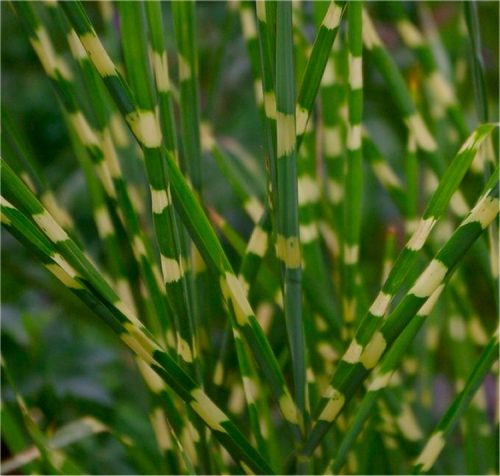Miscanthus Sinensis ‘Flamingo’
Miscanthus Sinensis ‘Flamingo’, commonly referred to as Chinese silver grass, silver grass flamingo, Eulalia grass, Eulalia flamingo, maiden grass, zebra grass, Susuki grass, or porcupine grass is a flowering plant native to Asia. It is a widely cultivated variety especially in temperate regions of the world and is valued for a beautiful ornamental grass.
Miscanthus Sinensis ‘Flamingo’ is a grassy plant that has narrow, arching, mid to dark green leaves and red-flushed stems in late summer and early autumn, with white prominent midribs that turn orange-gold shades in the fall; and slightly pendant, feathery flower plumes which bloom in late summer.
It flowers earlier than many Miscanthus varieties. At first, each plume is pink-tinged then later delicately changes to a silvery-white colour as it ages-rising well above the elegant foliage.
This perennial plant with elegant foliage grows in the wetlands, is deciduous, floriferous, and has a clump-forming habit; capable of spreading 3 tom4 feet in width and growing to a height of 5 to 6 feet in about 2 to 5 years.
Miscanthus Propagation Methods
Chinese silver grass is best propagated by division and seed, having the plant dug up and divided or sowing the seeds in a cold frame in early spring.
Growing Conditions for Miscanthus
Miscanthus species are generally hardy and can be planted in autumn, although the best time to plant them is in late spring. They can be slow in establishing their roots but are fast-growing and considered versatile, low-maintenance plants of great winter interest.
Also, they have invasive tendencies (especially in the US) and require space, although this attribute is dormant in the UK. However, a best gardening practice is to not plant more than one cultivar in the same space.
- Soil: Miscanthus flamingo tolerates most soils and can be planted in any moderately fertile, moist, and well-draining with a pH range of 5 to 7.5. They will do well in chalky, clay, loamy, or sandy soil of acidic, alkaline or neutral nature.
- Light: Miscanthus flamingos can be planted in full sun to light or partial shade, although they perform best in full sun in terms of growth, width, and movement. They flower best after a hot sunny period and hence, planting them in deep shade is not advised.
- Water: Miscanthus flamingo plants should be well-watered but not over-watered in the first year after planting until their roots get established. They are drought-tolerant and hence require only occasional watering; watering isn’t required in the presence of sufficient rainfall. They should be protected from winter wetness as that could cause their roots to rot and other diseases might emerge from that.
- Temperature: Miscanthus flamingo plants are very receptive to warm temperatures from early to mid-summer, as they aid in their growth. They are also full frost-hardy, capable of withstanding temperatures of up to -29 to 5 degrees Fahrenheit.
- Pruning: Miscanthus flamingo plants look good all year round, but might need to be cut back in spring. It is recommended to tie up the leaves and remove dead foliage and old flowered stems, cutting them to the ground in late winter to early spring before new shoots appear-encouraging new growth again.
- Fertiliser: Miscanthus flamingo plants thrive well on their own and do not require feeding from fertilizer. However, the addition of mulched well-rotted manure or organic matter and grit to the soil is acceptable. Feeding, in any case, should occur only once every year, preferably in late winter or early spring as too much fertilizer can lead to the plant flopping.
- Insects and Diseases: Miscanthus flamingo plants are largely free of pests and diseases. They are deer and rabbit resistant but attractive to birds.





